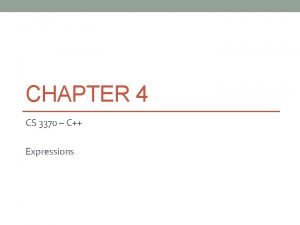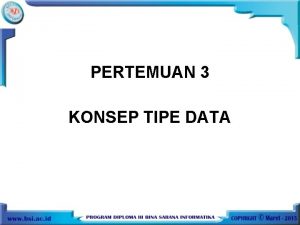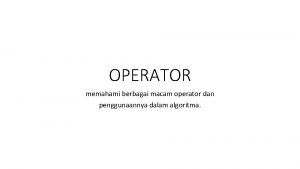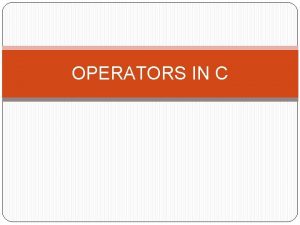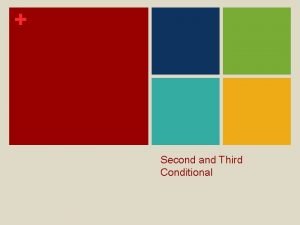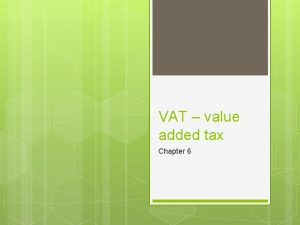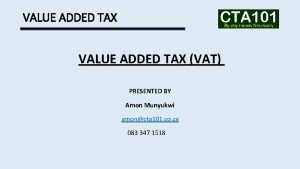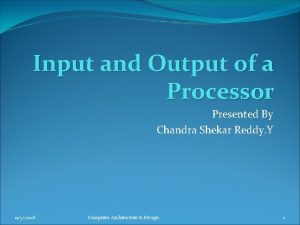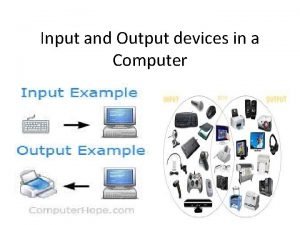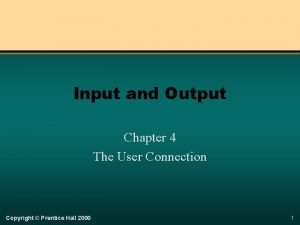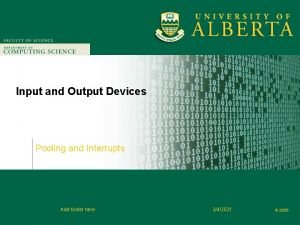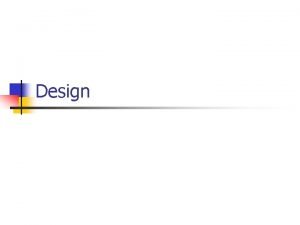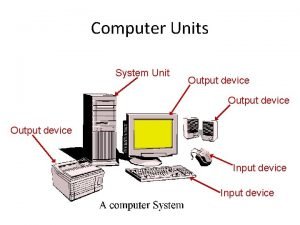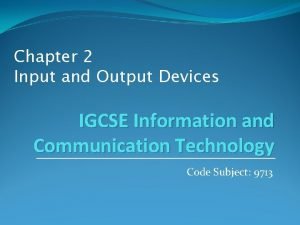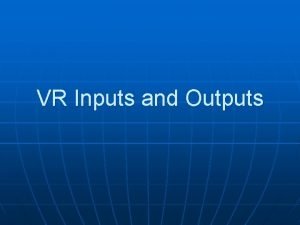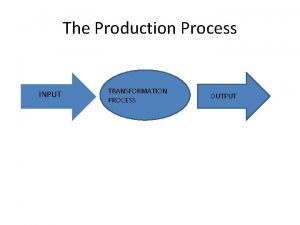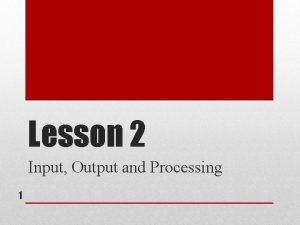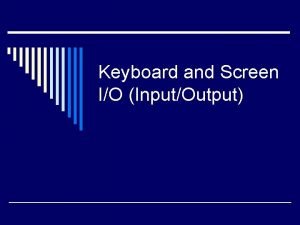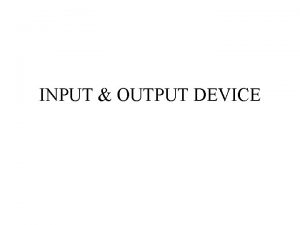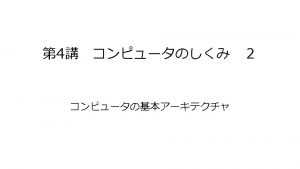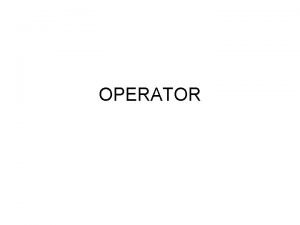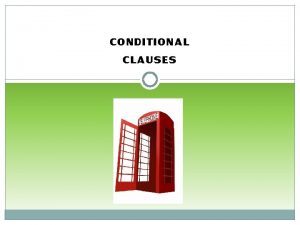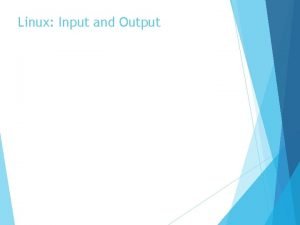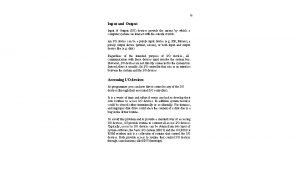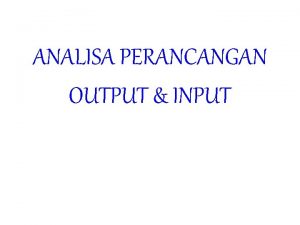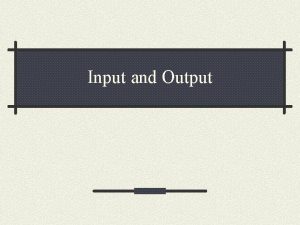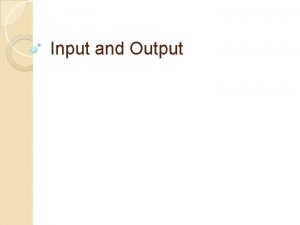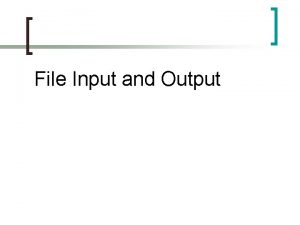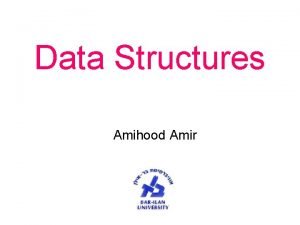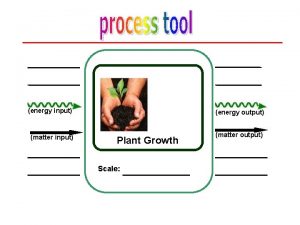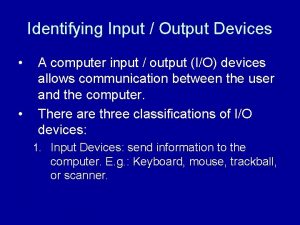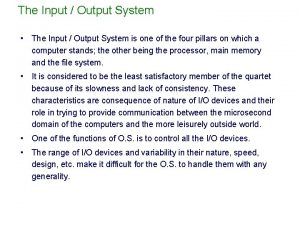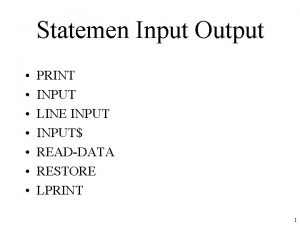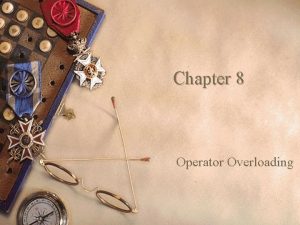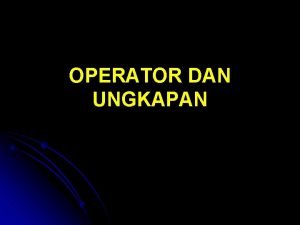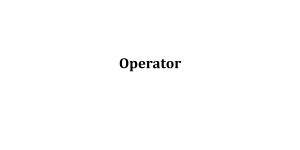Input and Output Lecture 4 Conditional Operator The































- Slides: 31

Input and Output – Lecture 4 Conditional Operator • The conditional operator (? : ) is used to simplify an if/else statement – Condition ? Expression 1 : Expression 2; • The statement above is equivalent to: if (Condition) Expression 1; else Expression 2; • Which are more readable? Department of Computer Engineering 1 Sharif University of Technology

Input and Output – Lecture 4 Conditional Operator • Example: if/else statement: if (total > 12) grade = ‘P’; else grade = ‘F’; conditional statement: (total > 12) ? grade = ‘P’: grade = ‘F’; OR grade =( total > 12) ? ‘P’: ‘F’; Department of Computer Engineering 2 Sharif University of Technology

Input and Output – Lecture 4 Conditional Operator • Example: if/else statement: if (total > 12) printf(“Passed!!n”); else printf(“Failed!!n”); Conditional Statement: printf(“%s!!n”, total > 12 ? “Passed”: “Failed”); Department of Computer Engineering 3 Sharif University of Technology

Input and Output – Lecture 4 Precedence Rules • The rules specify which of the operators will be evaluated first – For example: x = 3 * a - ++b%3; Precedence 1 (highest) 2 3 4 5 (lowest) Operator Associativity Level () unary * / % + = += -= *= /= %= Department of Computer Engineering 4 left to right to left to right to left Sharif University of Technology

Input and Output – Lecture 4 Precedence Rules • how would this statement be evaluated? – : x = 3 * a - ++b % 3; – What is the value for X, for: a = 2, b = 4? x = 3 * a - ++b % 3; x = 3 * a - 5 % 3; x = 6 – 2; x = 4; Department of Computer Engineering 5 Sharif University of Technology

Input and Output – Lecture 4 Precedence Rules • If we intend to have a statement evaluated differently from the way specified by the precedence rules, we need to specify it using parentheses ( ) – x = 3 * a - ++b % 3; • Consider having the following statement: – x = 3 * ((a - ++b)%3); – the expression inside a parentheses will be evaluated first • The inner parentheses will be evaluated earlier compared to the outer parentheses Department of Computer Engineering 6 Sharif University of Technology

Input and Output – Lecture 4 Precedence Rules • how would this statement be evaluated? – x = 3 * ((a - ++b)%3); – What is the value for X, for: a = 2, b = 4? x = 3 * ((a - ++b) % 3); x = 3 * ((a - 5) % 3); x = 3 * ((-3) % 3); x = 3 * 0; x = 0; Department of Computer Engineering 7 Sharif University of Technology

Input and Output Lecture 4 Department of Computer Engineering 8 Sharif University of Technology

Input and Output – Lecture 4 Outline • Review • printf • scanf Department of Computer Engineering 9 Sharif University of Technology

Input and Output – Lecture 4 Input and Output in C • C has no built-in statements for IO – The I/O library functions are in <stdio. h> • All input and output is performed with streams – A stream is a sequence of characters organized into lines To be, or not to be? T o b e o r . . . That is the question. – Standard types of streams in C: • stdin: input stream (normally connected to the keyboard) • stdout: output stream (normally connected to the screen) • stderr: error stream (normally connected to the screen) Department of Computer Engineering 10 Sharif University of Technology

Input and Output – Lecture 4 Department of Computer Engineering 11 Sharif University of Technology

Input and Output – Lecture 4 Formatted Output - printf • This function provides formatted output to the screen. The syntax is: printf ("format", var 1, var 2, … ) ; • The format includes, some text and conversion specifications • A conversion specifier begins with the % character. After the % character come the following in this order: – [flags]: control the conversion (optional) – [width]: the minimum number of characters to print (optional) – [. precision]: the maximum amount of precision to print for a number type (optional) – [modifier]: overrides the size (type) of the argument (optional) – [type]: the type of conversion to be applied (required) – Example: %[flags][width][. precision][modifier]type Department of Computer Engineering 12 Sharif University of Technology

Input and Output – Lecture 4 Conversion specifier: type Type d, i o u x X f e, E Output Type signed int Type unsigned int printed in octal Type unsigned int printed in decimal Type unsigned int printed in hexadecimal as dddd using a, b, c, d, e, f Type unsigned int printed in hexadecimal as dddd using A, B, C, D, E, F Type double printed as [-]ddd. ddd Type double printed as [-]d. ddde[-]dd where there is one digit printed before the decimal (zero only if the value is zero); the exponent contains at least two digits. If type is E then the exponent is printed with a capital E g, G Type double printed as type e or E if the exponent is less than -4 or greater than or equal to the precision, otherwise printed as type f. Trailing zeros are removed. Decimal point character appears only if there is a nonzero decimal digit c Type char; single character is printed s Type pointer to array; string is printed according to precision (no precision prints entire string) p Prints the value of a pointer (the memory address) n The argument must be a pointer to an int. Stores the number of characters printed thus far % A % sign is printed Department of Computer Engineering 13 Sharif University of Technology

Input and Output – Lecture 4 Example: type #include <stdio. h> // note: preprocessor does not need semicolon /* Objective: Using conversion specifiers */ int main() { // start main int i = 1234; float m = 12. 5, n = -12. 5; printf("%d %o %x %Xn", i, i); printf("%f %fn", m, n); printf("%e %e %En", n, m, n); printf("%g %gn", m, n); printf("%sn", "string"); printf("-------n"); printf("%d %dn", i); printf("%dn", i, i); printf("%d"); return 0; } // end main Department of Computer Engineering 14 Sharif University of Technology

Input and Output – Lecture 4 Example: type #include <stdio. h> /* Objective: Using conversion specifiers */ int main() { // start main int i = 1234; float m = 12. 5, n = -12. 5; char c = 'A'; m = c; printf("%fn", 18); //meaningless; if 18 replace by 18. 0 then it is OK. printf("%fn", c); //meaningless printf("%fn", m); i = c; printf("%dn", i); printf("%dn", c); i = m; // i = 65; printf("%dn", i); printf("%dn", m); //meaningless printf("%dn", 12. 6); //meaningless //printf("%s %s %s", i, m, c); // meaningless OR rumtime-error return 0; // indicates successful termination } // end main Department of Computer Engineering 15 Sharif University of Technology

Input and Output – Lecture 4 Width • The width of the field is specified here with a decimal value • If the value is not large enough to fill the width, then the rest of the field is padded with spaces (unless the 0 flag is specified) • If the value overflows the width of the field, then the field is expanded to fit the value • If a * is used in place of the width specifer, then the next argument (which must be an int type) specifies the width of the field. – printf( "%*f", 7, 98. 736 ); Department of Computer Engineering 16 Sharif University of Technology

Input and Output – Lecture 4 Example int i = 1234; float m = 12. 5; float n = -12. 5; printf("%d%d%dn", i, i, i); printf("%3 d%5 d%8 dn", i, i, i); printf("%3 s%5 sn", "test", "c"); printf("%3 f %5 f %12 fn", m, n, n); printf("%3 g %6 g %8 gn", m, n, n); Department of Computer Engineering 17 Sharif University of Technology

Input and Output – Lecture 4 Precision • The precision begins with a dot (. ) to distinguish itself from the width specifier • The precision can be given as a decimal value or as an asterisk (*) – If a * is used, then the next argument (which is an int type) specifies the precision – when using the * with the width and/or precision specifier, the width argument comes first, then the precision argument, then the value to be converted – printf("%*. *f", 3, 2, 98. 736 ); • Precision does not affect the c type Department of Computer Engineering 18 Sharif University of Technology

Input and Output – Lecture 4 Example # include <stdio. h> /* Objective: example of conversion specifiers */ int main() { int i = 1234; float m = 123. 525; printf("%7. 3 f %7. 2 f %7. 1 f %7. 0 f %7. 5 fn", m, m, m); printf("%4 d %5. 2 d %5. 6 d %8. 5 dn", i, i); printf("%3 s %12. 5 s %. 13 sn", "programming", "programming"); return 0; // indicates successful termination } // end main Department of Computer Engineering 19 Sharif University of Technology

Input and Output – Lecture 4 Example #include <stdio. h> /* Objective: example of conversion specifiers */ int main() { int i = 1234; float m = 123. 0; printf("%#7. 0 f %g %#gn", m, m, m); printf("%d %07 d %-7 d %+d %d %dn", i, i, i, -i); printf("%o %#o %x %#xn", 025, 0 x 25); printf("%+0 d %09 d %+09 dn", 445, 445); return 0; // indicates successful termination } // end main Department of Computer Engineering 20 Sharif University of Technology

Input and Output – Lecture 4 Formatted input - scanf • Input formatting scanf("format", arguments); – Input all types of data – Input specific characters – Skip specific characters • Format: an input field is specified with a conversion specifer which begins with the % character. After the % character come the following in this order: – [*] Assignment suppressor (optional). – [width] Defines the maximum number of characters to read (optional). – [modifier] Overrides the size (type) of the argument (optional). – [type] The type of conversion to be applied (required). – Example: %*[width][modifier]type • % * 12 L g Arguments: pointers to variables where input will be stored (address of variables) Department of Computer Engineering 21 Sharif University of Technology

Input and Output – Lecture 4 scanf • These functions take input in a manner that is specified by the format argument and store each input field into the following arguments in a left to right fashion • Each input field is specified in the format string with a conversion specifier which specifies how the input is to be stored in the appropriate variable Department of Computer Engineering 22 Sharif University of Technology

Input and Output – Lecture 4 type • What kind of characters it can read so it can convert to something compatible Department of Computer Engineering 23 Sharif University of Technology

Input and Output – Lecture 4 type Input d Type signed int represented in base 10. Digits 0 through 9 and the sign (+ or -) i Type signed int. The base (radix) is dependent on the first two characters. If the first character is a digit from 1 to 9, then it is base 10. If the first digit is a zero and the second digit is a digit from 1 to 7, then it is base 8 (octal). If the first digit is a zero and the second character is an x or X, then it is base 16 (hexadecimal) o Type unsigned int. The input must be in base 8 (octal). Digits 0 through 7 only u Type unsigned int. The input must be in base 10 (decimal). Digits 0 through 9 only x, X Type unsigned int. The input must be in base 16 (hexadecimal). Digits 0 through 9 or A through Z or a through z. The characters 0 x or 0 X may be optionally prefixed to the value e, E, f, g, G Type float. Begins with an optional sign. Then one or more digits, followed by an optional decimal-point and decimal value. Finally ended with an optional signed exponent value designated with an e or E s Type character array. Inputs a sequence of non-whitespace characters (space, tab, carriage return, new line, vertical tab, or formfeed). The array must be large enough to hold the sequence plus a null character appended to the end [. . . ] Type character array. Allows a search set of characters. Allows input of only those character encapsulated in the brackets (the scanset). If the first character is a carrot (^), then the scanset is inverted and allows any ASCII character except those specified between the brackets. On some systems a range can be specified with the dash character (-). By specifying the beginning character, a dash, and an ending character a range of characters can be included in the scan set. A null character is appended to the end of the array c Type character array. Inputs the number of characters specified in the width field. If no width field is specified, then 1 is assumed. No null character is appended to the array p Pointer to a pointer. Inputs a memory address in the same fashion of the %p type produced by the printf function. n The argument must be a pointer to an int. Stores the number of characters read thus far in the int. No characters are read from the input stream % Requires a matching % sign from the input Department of Computer Engineering 24 Sharif University of Technology

Input and Output – Lecture 4 Example int main() { 5 1 0. 5 � int i; Number Space Number float f; scanf("%d %f", &i, &f); // space between conversion specifer is important for char type scanf("%d%f", &i, &f); 5 1 0. 5 � Number Tab Number printf("i = %d, f = %f", i, f); return 0; } 5 � Number Enter Number 1 0. 5 � Department of Computer Engineering 25 Sharif University of Technology

Input and Output – Lecture 4 Example int main() { int i; 1 0 i = 8 } scanf("%i", &i); printf("i = %d", i); return 0; i = 1 0 0 1 0 // scanf("%d", &i); 0 x 1 0 i = 1 6 0 x 1 0 i = 0 Department of Computer Engineering 26 Sharif University of Technology

Input and Output – Lecture 4 Example int main() { char c; scanf("%c", &c); printf("c = %c", c); return 0; } 6 5 c = A A c = A Department of Computer Engineering 27 Sharif University of Technology

Input and Output – Lecture 4 Example int main() { unsigned short j; short k; scanf("%u %u", &k, &j); printf("%u, %u", k, j); printf("%d, %d", k, j); } return 0; Department of Computer Engineering 28 Sharif University of Technology

Input and Output – Lecture 4 Width • The maximum width of the field is specified here with a decimal value Department of Computer Engineering 29 Sharif University of Technology

Input and Output – Lecture 4 Example int main() { int i, j, k; 1 2 3 scanf("%3 d %3 d", &i, &j, &k); 1 4 2 3 5 6 4 9 8 return 0; } 1 4 2 6 5 6 6 4 8 1 4 2 6 9 5 6 6 4 9 8 Department of Computer Engineering 30 a b c 1 2 3 142 356 498 142 6 566 142 695 664 Sharif University of Technology

Input and Output – Lecture 4 Example int main() { int i; float f; char c; scanf("%3 d %5 f %c", &i, &f, &c); } return 0; Department of Computer Engineering 1 0 31 2 3 6. 8 7 5 T � Sharif University of Technology
 Unary binary operator
Unary binary operator Pada tipe data boolean, berlaku operator-operator
Pada tipe data boolean, berlaku operator-operator Pada tipe data boolean, berlaku operator-operator
Pada tipe data boolean, berlaku operator-operator Berbagai macam operator beserta prioritas operator
Berbagai macam operator beserta prioritas operator 01:640:244 lecture notes - lecture 15: plat, idah, farad
01:640:244 lecture notes - lecture 15: plat, idah, farad Input design
Input design Advantages of input devices
Advantages of input devices Assignment operators example
Assignment operators example Past real conditional sentences
Past real conditional sentences Input devices of virtual reality
Input devices of virtual reality Input vat and output vat
Input vat and output vat Input vat and output vat
Input vat and output vat Input vs output vat
Input vs output vat What is output
What is output Input and output devices of computer
Input and output devices of computer Conclusion for input and output devices of computer
Conclusion for input and output devices of computer Input and output devices for visually impaired
Input and output devices for visually impaired Input and output devices
Input and output devices How to draw input devices
How to draw input devices Input and output devices conclusion
Input and output devices conclusion Human input output channels
Human input output channels Computer science input and output
Computer science input and output Most abstract input and output in software engineering
Most abstract input and output in software engineering Is system unit an output device
Is system unit an output device Output device
Output device Krebs cycle outputs
Krebs cycle outputs Vr input and output devices
Vr input and output devices Input and output of krebs cycle
Input and output of krebs cycle What is the input–transformation–output process?
What is the input–transformation–output process? Analog input and output devices
Analog input and output devices Specialized input devices
Specialized input devices Screen output and keyboard input
Screen output and keyboard input
